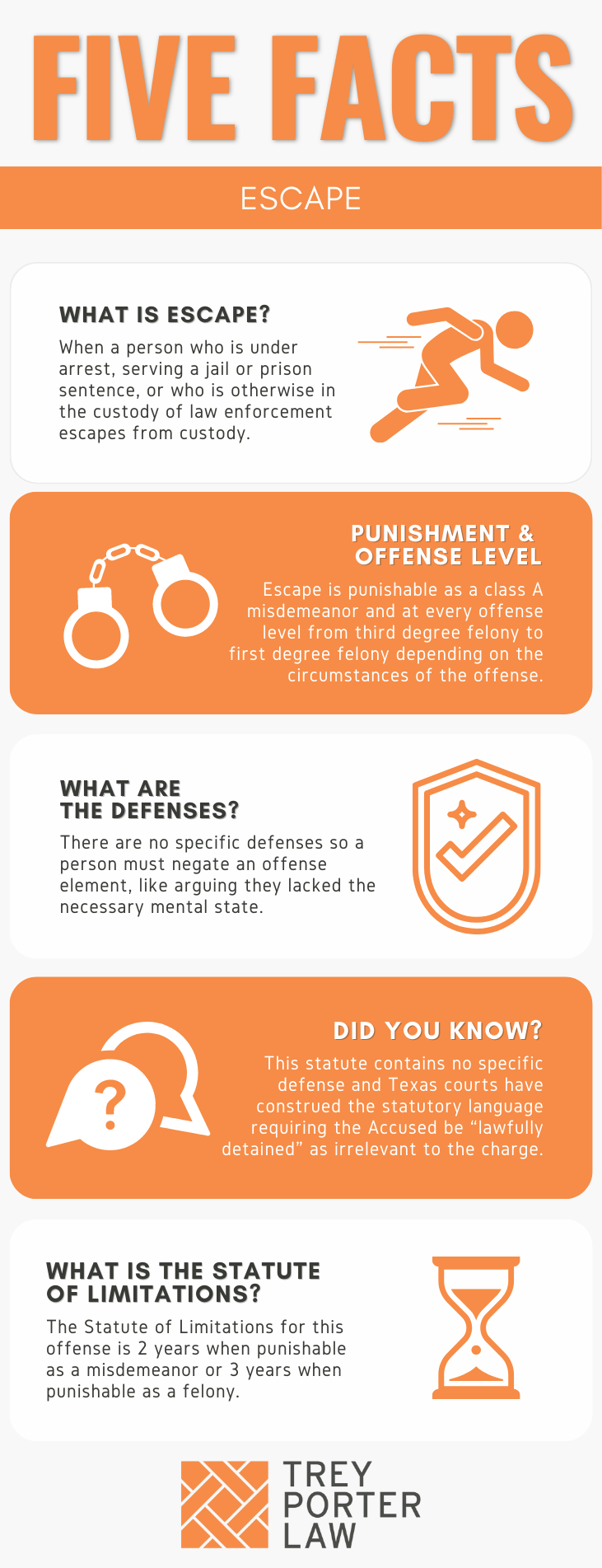

The Texas law against escape prohibits a person in custody who is charged with, convicted of, or detained or under arrest for an offense from moving outside the bounds of confinement without authority.


(a) A person commits an offense if the person escapes from custody when the person is:
(1) under arrest for, lawfully detained for, charged with, or convicted of an offense;
(2) in custody pursuant to a lawful order of a court;
(3) detained in a secure detention facility, as that term is defined by Section 51.02, Family Code; or
(4) in the custody of a juvenile probation officer for violating an order imposed by the juvenile court under Section 52.01, Family Code.
(b) Except as provided in Subsections (c), (d), and (e), an offense under this section is a Class A misdemeanor.
(c) An offense under this section is a felony of the third degree if the actor:
(1) is under arrest for, charged with, or convicted of a felony;
(2) is confined or lawfully detained in a secure correctional facility or law enforcement facility; or
(3) is committed to or lawfully detained in a secure correctional facility, as defined by Section 51.02, Family Code, other than a halfway house, operated by or under contract with the Texas Juvenile Justice Department.
(d) An offense under this section is a felony of the second degree if the actor to effect his escape causes bodily injury.
(e) An offense under this section is a felony of the first degree if to effect his escape the actor:
(1) causes serious bodily injury; or
(2) uses or threatens to use a deadly weapon.
The penalty classification for escape depends on the severity of the conduct, and the escapee’s status at the time of the offense. By default, escape from custody is a Class A misdemeanor, punishable by up to one year in county jail. The penalty category for escape is increased to a:

A person charged with escape may face a punishment range of up to one year in jail, or up to life in prison, depending on the person’s conduct.
A person charged with escape may be eligible for either probation after a conviction, or deferred adjudication without a conviction. The maximum term of community supervision for a first degree, second degree, or third degree felony escape is ten years. The period of community supervision for a Class A misdemeanor escape charge may not exceed two years.

The statute does not authorize specific defenses to escape. A person accused thereof may assert any of the justification defenses, or attempt to negate at least one of the elements the State must prove at trial.
The limitation period for escape categorized as a Class A misdemeanor is two years. If the escape is classified as a felony, the limitation period is three years.

In 2011, the Legislature expanded the application of the escape statute to those who were “lawfully detained for” a crime. Texas courts, however, continue to hold that escape can only occur after an officer has successfully restrained or restricted a suspect’s movement.
The case law regarding escape in Texas shows that, despite the Legislature’s 2011 amendment adding the “lawfully detained for” language, courts continue to require a restriction of a person’s liberty beyond an ordinary investigative detention to sustain an escape conviction.

Trey Porter is one of the highest-rated criminal defense attorneys in Texas. Nationally recognized, Mr. Porter relentlessly fights to protect and assert his clients’ constitutional rights in and out of courtrooms across the state.






![]()
Exceptional Defense Attorneys and firm.
I had the pleasure of being represented by Trey Porter Law. Attorney Joseph Strickland worked with me directly and was wit me at every court appearance and I couldn't be more satisfied with the outcome. From the outset, they set clear expectations on how they could help me avoid jail time for my DWI charge.
What truly stood out was their unwavering support throughout the entire process. They were always accessible, promptly addressing any questions I had. Ms. Aisley would answer my call and respond to my questions on the spot. This was especially crucial when my school and potential employers raised concerns about my pending charges. Joseph Strickland provided guidance on how to navigate these external challenges, showcasing their commitment to their clients beyond the courtroom.
Their professionalism, transparent communication, and dedication to my case made a significant impact, and I am grateful for the positive resolution they achieved. I highly recommend Trey Porter Law Firm for anyone in need of a skilled and supportive defense attorney and team.
![]()
After a search of attorneys in my area I sought out Trey Porter Law Firm, impressed by the detailed information provided on the website and resounding client endorsements. From the introductory phone call, direct meeting, subsequent calls/emails/texts, and throughout my court appearance and disposition, all dealings have been exceptional. Everyone on the team has been friendly and responsive, while still being highly professional. I also very much appreciate the proactive approach taken throughout my case.
![]()
Mr. Porter an amazing attorney, he help me get through my situation swiftly and professionally as well as save me time and money in the process. Working with Mr. Porter was a pleasure, he kept me well informed and updated throughout the whole process which made things so much easier for me to understand. Mr. Porter and his team took the stress out of stressful situation. Mr. Porter and his team was always easy to contact and return my phone calls and emails promptly. I cannot give enough praise to Mr. Porter and his team. I had another attorney in the beginning who wad basically going to railroad me. I would definitely recommend Mr. Trey Porter again and again. If you’re looking for a great attorney who is affordable and knowledgeable and will fight for you, Trey Porter is the attorney to choose. Definitely a five star attorney.
![]()
Trey and his staff are great and make sure to help you with all your questions to get through the process. Trey worked out the best outcome for my issue and got me an opportunity to get my charge expunged. Trey and his team made a negative experience end on a positive note. Truly recommend this law firm for your legal issues.
![]()
I would like to thank Trey Porter and his team regarding my DUI case. I truly could not have expected a better outcome regarding my case. This outcome only happened because of his expert knowledge and dedication to his profession. Trey really took time to explain every step of the process to me which really helped me make critical decisions on how to proceed. I am lucky to have come across his name and will only refer people to Mr. Porter regarding DUI offenses. Trey, I want to thank you publicly. Your expert handling of my D.U.I. got my case reduced to an outcome I was very pleased with. Nothing against my driving record, no loss of license and I’m positive this wouldn’t have turned out so well without you. Thanks for your hard work, empathy and responsiveness it really meant a lot to me.
![]()
We hired Trey Porter to assist us last year. From the initial consultation up to and including the court hearing, Trey had a straight forward approach to the situation at hand. He explained everything along the way and was available at any time to discuss/answer any questions we had either by phone/text/email. With his experience and professionalism, we obtained the best outcome possible. We would highly recommend Trey Porter with no hesitation whatsoever. Five stars is definitely not enough!
![]()
I highly recommend Trey Porter! He is very professional and attentive to each situation at hand. He does not beat around the bush. Straight forward and explains things very well. Easy to work with. Contacts you before you have to ever contact him. Detailed oriented. Driven to get you the best deal possible in your situation. Him and his staff were absolutely amazing for my situation. Thank you!
![]()
Trey is a phenomenal attorney that gets the job done right! He is dedicated to help his clients. He made himself available and answered all my concerns immediately! I had faith in him and he continued to prove his expertise by helping me. I highly recommend Trey Porter!!
![]()
Mr. Porter was exceptional! He answered all my questions, was thorough throughout my case. Really pushed to go above and beyond to get us the results we were needing. Excellent professional service and as a professional I can definitely say I recommend him.
![]()
100/100
Excellent experience with Mr Porter and TPL law offices. They fought for me and they won! I hired Mr Porter after an embarrassing incident. My license and employment were on the line. The office had excellent communication and personal service — even through text message! Totally recommend Trey Porter 100/100!
![]()
5 STAR!
I hired Mr. Porter to represent my son in a DUI case. I was worried a conviction would ruin his future. Mr. Porter and the whole office were friendly, thorough, and poised throughout. They respond to text and calls almost instantly. We are just finishing the expunction process after the case was dismissed. I am grateful to Mr. Porter and recommend him to one and all. Excellent from start to finish. Thank you TPL!
![]()
Winning
I won with Attorney Trey Porter! Had a criminal DWI .15 charge, small accident, but no injuries. This was my first criminal charge of my life. Mr. Porter was great to talk to — as was the entire office staff and other attorneys. Everyone was SO NICE! 9 long months passed and my charge was dismissed. No probation. No conviction. This experience was well worth the money. I recommend Trey Porter, Attorney at Law.